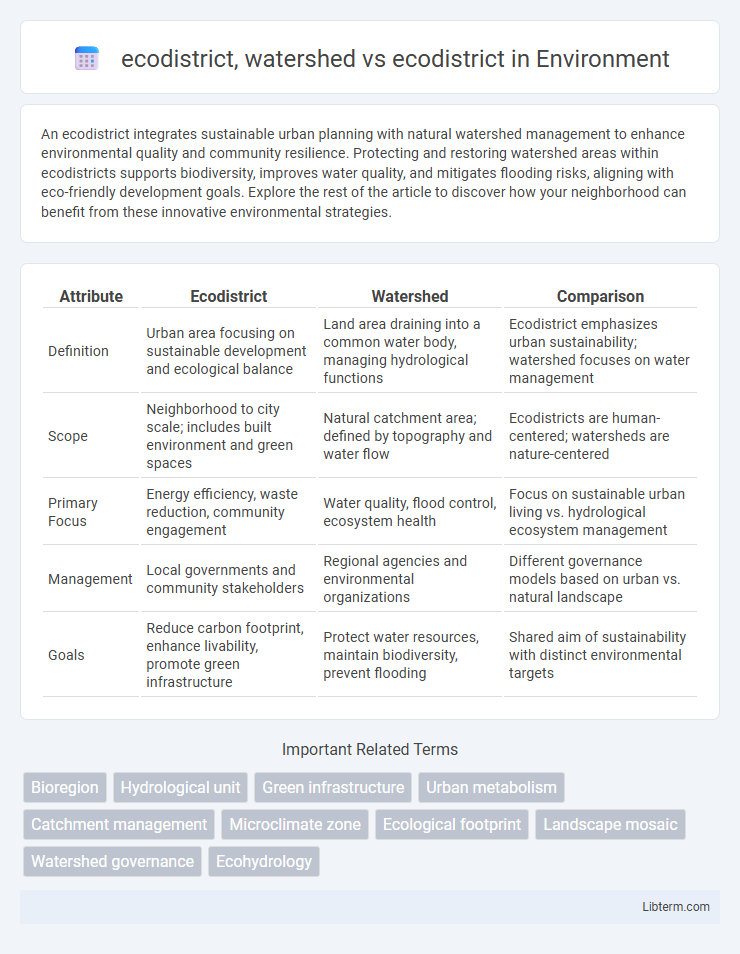An ecodistrict integrates sustainable urban planning with natural watershed management to enhance environmental quality and community resilience. Protecting and restoring watershed areas within ecodistricts supports biodiversity, improves water quality, and mitigates flooding risks, aligning with eco-friendly development goals. Explore the rest of the article to discover how your neighborhood can benefit from these innovative environmental strategies.
Table of Comparison
| Attribute | Ecodistrict | Watershed | Comparison |
|---|---|---|---|
| Definition | Urban area focusing on sustainable development and ecological balance | Land area draining into a common water body, managing hydrological functions | Ecodistrict emphasizes urban sustainability; watershed focuses on water management |
| Scope | Neighborhood to city scale; includes built environment and green spaces | Natural catchment area; defined by topography and water flow | Ecodistricts are human-centered; watersheds are nature-centered |
| Primary Focus | Energy efficiency, waste reduction, community engagement | Water quality, flood control, ecosystem health | Focus on sustainable urban living vs. hydrological ecosystem management |
| Management | Local governments and community stakeholders | Regional agencies and environmental organizations | Different governance models based on urban vs. natural landscape |
| Goals | Reduce carbon footprint, enhance livability, promote green infrastructure | Protect water resources, maintain biodiversity, prevent flooding | Shared aim of sustainability with distinct environmental targets |
Introduction to Ecodistricts
Ecodistricts represent a sustainable urban planning approach that integrates environmental, social, and economic goals within a defined neighborhood or district. Unlike a watershed, which is a natural hydrological boundary defined by the area draining into a single water body, an ecodistrict is designed to optimize resource efficiency, reduce carbon footprint, and enhance community resilience through sustainable infrastructure and green spaces. Ecodistricts incorporate comprehensive strategies for energy use, water management, waste reduction, and transportation, making them key models for sustainable urban development.
Defining Watersheds and Ecodistricts
Watersheds are hydrological units defined by the land area where all surface water converges to a single outlet, critical for managing water resources and ecological health. Ecodistricts represent ecological subdivisions based on landform, soil, vegetation, and climate patterns, providing a framework for sustainable environmental planning. Understanding the distinct spatial boundaries and functional characteristics of watersheds and ecodistricts enhances targeted conservation and resource management strategies.
Core Principles of Ecodistrict Development
Ecodistrict development centers on sustainable urban planning, emphasizing integrated resource management, equitable community engagement, and resilient infrastructure tailored to local ecosystems. Watershed planning focuses primarily on hydrological cycles, water quality, and natural habitats within a specific drainage area, often lacking broader social and urban design considerations present in ecodistricts. Core principles of ecodistricts include promoting circular economies, enhancing biodiversity, fostering social equity, and implementing adaptive governance to ensure long-term environmental and community well-being.
Key Differences: Watershed vs Ecodistrict
A watershed is a land area that channels rainfall and surface water to a common outlet, emphasizing hydrological and ecological functions within its geographic boundary. An ecodistrict integrates broader environmental, social, and infrastructural components, focusing on sustainable urban planning and ecosystem health at a neighborhood or district scale. Key differences include watersheds' primary role in water management versus ecodistricts' multifaceted approach to holistic environmental governance and community development.
Environmental Impact: Watershed vs Ecodistrict
Watersheds manage environmental impact by controlling water flow, reducing pollution, and preserving aquatic ecosystems within a natural drainage area, essential for maintaining water quality and preventing floods. Ecodistricts integrate sustainable urban planning by combining green infrastructure, renewable energy, and biodiversity enhancement to reduce carbon footprints and improve overall ecosystem health in a defined urban area. Comparing both, watersheds emphasize hydrological processes and water resource management, while ecodistricts focus on holistic environmental strategies that address energy, waste, and habitat within a human-centered landscape.
Governance and Management Structures
Ecodistrict governance structures emphasize collaborative management involving local stakeholders, prioritizing sustainability, resilience, and community engagement within defined urban boundaries. Watershed management frameworks focus on integrated, multi-jurisdictional coordination across ecological units, addressing water quality, land use, and ecosystem health through regulatory agencies and cross-boundary partnerships. Both models require adaptive governance but differ in spatial scope and stakeholder integration, with ecodistricts concentrating on urban neighborhoods and watersheds encompassing broader hydrological landscapes.
Benefits of Ecodistricts for Urban Sustainability
Ecodistricts promote urban sustainability by integrating green infrastructure, efficient water management, and energy-efficient building designs, reducing environmental impact within designated watershed areas. Unlike traditional watershed management that focuses primarily on water quality and runoff control, ecodistricts holistically address social, economic, and environmental goals, fostering resilient communities with improved air quality, biodiversity, and reduced carbon footprints. This comprehensive approach enhances resource efficiency, supports climate adaptation, and encourages sustainable urban growth.
Challenges in Ecodistrict and Watershed Integration
Ecodistrict and watershed integration faces key challenges including aligning varied governance structures, managing conflicting land-use priorities, and ensuring equitable stakeholder engagement across both ecological and urban systems. Data discrepancies in monitoring environmental indicators complicate adaptive management practices essential for sustainable development. Effective integration demands harmonized policies, cross-sector collaboration, and robust spatial planning tools to balance ecological preservation with community resilience.
Case Studies: Successful Ecodistricts and Watershed Projects
Case studies of successful ecodistricts, such as Vancouver's Southeast False Creek and Stockholm Royal Seaport, demonstrate integrated urban planning emphasizing sustainable infrastructure, energy efficiency, and community engagement. In contrast, watershed projects like the Chesapeake Bay Program and the Rhine River Restoration focus on water quality improvement, habitat restoration, and managing agricultural and urban runoff across multiple political boundaries. These examples highlight the distinct goals and scales of ecodistrict and watershed initiatives, with ecodistricts prioritizing localized urban sustainability and watershed projects addressing broader ecological health and water management.
Future Trends in Sustainable Urban Planning
Ecodistricts integrate ecosystem services and community-based approaches to enhance urban resilience, contrasting with traditional watershed management that primarily focuses on hydrological boundaries. Future trends in sustainable urban planning emphasize ecodistricts as multifunctional spaces combining green infrastructure, renewable energy, and social equity to create climate-adaptive cities. Innovations in data-driven design and participatory governance are driving the evolution of ecodistricts beyond watershed constraints, promoting holistic urban sustainability and biodiversity conservation.
ecodistrict, watershed Infographic

 libterm.com
libterm.com